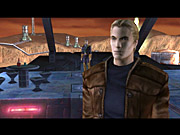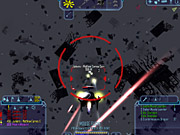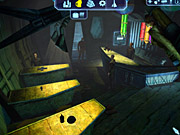Freelancer Updated Preview
Digital Anvil's expansive space combat game has been in the works for years, and we've played a beta version to see if it's likely to live up to its potential.
It's almost a law of computer game physics that not all games labeled vaporware remain that way. Announced back in 1998, Freelancer has survived numerous rumors of its demise, as well as the departure of Digital Anvil's founder, Chris Roberts, and the purchase of the studio by Microsoft. Now, not only are we reporting on Freelancer's upcoming release, but we're doing so after having extensively played a fully functional beta version of the game. What's more, it looks to be really good.

You play as Edison Trent, a freelance pilot in the mold of Han Solo. As you explore the universe, you'll meet a series of characters, participate in a developed storyline with numerous cutscenes, and travel around the universe as a lone pilot out to succeed in a hostile universe. Unfortunately, the spoken cutscenes don't quite live up to the rest of the game, but with the foolproof mission system (just hit "N" to have your current objective flash on the screen in large letters) you'll never wonder what you have to do next, if you in fact have to do anything. One of the great things about Freelancer is that most of the time you can do whatever you want.
For a game that has been in development this long, Freelancer looks surprisingly good. In a space game, the most important thing is to keep every planet from looking like every other planet so that the universe seems like more than just an assortment of suspended billiard balls. Freelancer does this through the effective use of lighting, color, and different environments around the planets. Many are surrounded by asteroids or debris, further adding to the environmental diversity. As you learn the layout of the trade lanes (which you can use to drastically decrease travel times between planets) and then the jump gates, the game will start to flesh out into a memorable universe.

Gameplay in Freelancer is quite open-ended. There is a complete story in the solo game, but that's only one part of the action. As you move from planet to planet and from system to system, you can get missions (by visiting the bar on each planet), buy or sell a ship or weapons (at the equipment or ship dealer), trade in commodities (at the commodities trader), or just blast off into space and explore. Your primary goal is to make money so that you can buy better equipment, but of course, that's the goal of almost any computer game. What's striking about Freelancer is how various elements fit together to make something that's not just a space combat/trading sim, but more a kind of role-playing game in space. You won't increase your strength or dexterity, but you do gain levels, and you're always trying to buy better equipment.
While self-improvement is always your ultimate goal, exploration is always a close second. Freelancer rewards your wanderlust by making it possible to zoom through various worlds almost aimlessly, meeting characters and completing missions. You'll spend a lot of time in your ship, but you'll also spend a fair amount of time gathering information while planetside and learning about the game's various factions.
Balancing the different elements of the game clearly had to be a main focus of the design process, and it shows. One of the places this is most noticeable is the way in which combat is handled.
Fighting Conventions
Freelancer's combat system is unique for a space sim in that it doesn't require piloting in the traditional sense. Joystick veterans lamenting the demise of the true joystick-driven space simulation shouldn't despair, though, because the control system in Freelancer is actually quite neat. You can fly using traditional keyboard commands (WASD) in free flight mode, or you can use mouse flight, which was clearly designed for combat. Basically, you just point your mouse at the enemy, and the computer will fly you there. The degree to which the mouse is displaced from the center of the screen determines your vector in that direction, so moving your mouse slightly to the side will turn you a little bit, while throwing the pointer to the edge of the screen will turn you around. The free flight mode is best for noncombat situations when you need to use the mouse to interact with your HUD, but even then you can momentarily go into mouse flight mode by click-dragging to steer.

Gunnery is also simplified in that the targeting reticle adjusts for lead, meaning that if you have a high angle of attack, the computer automatically adjusts for this and moves the target cursor ahead of your target to indicate the proper place to aim. Just keep the mouse on the red cross and you'll hit your target. While hard-core space jocks will cringe at the idea, in practice it works very well. Targets are painted with exaggerated crosshairs to clearly identify them, and when they leave your field of view, indicators show their direction to help you maintain situational awareness.
This design approach allows for several things. Gamers who have never played a flight or space sim can comfortably sit down with Freelancer, sans joystick, and be able to complete missions. In addition, not having to spend all your time concentrating on maneuvers allows you to manage your weapons more closely, since the various weapon systems have different levels of effectiveness depending on what target they are hitting. Ships have a fixed number of hardpoints, and these hardpoints can be of various types, so tweaking out the perfect spacecraft is one of your goals as you progress through the game, buying better weaponry and assembling it based on the type of enemy you expect to face. You may use one type of weapon to take down an enemy's shields and another to damage his hull once the shields have been breached.

A result of this shooter approach is that the game's combat sequences are much more fast-paced and frantic than in a straight space sim. Flying through an asteroid field adds to the challenge since your aim will be spoiled if you bounce off one of the numerous chunks of floating debris you'll find around most objectives. It's not FreeSpace 2, nor was it meant to be. It's an accessible and enjoyable design that fits well into the game's larger framework, where a more complex flight and combat model would have made the other elements of the game take a backseat.
Because you are essentially a free agent, it would be difficult to integrate capital ships with large crews into the game with you in direct command. It would also be difficult to maintain adequate control over a large ship using the game's control scheme. For these reasons, it's not surprising that Freelancer restricts you to piloting various types of fighters. There are turrets, though, and you can even jump into a turret view and blast away at enemy fighters, which is how you'll defend yourself when you're piloting a freighter. The game captures these sci-fi combat conventions very well.
Travel the Galaxy
Of course, in a world as open-ended as Freelancer's, combat is just one of the options you have to advance your characters through the game. Because level advancement is based on net worth, you don't have to blow up enemies to gain power and influence. Instead, there are commodity traders from whom you can buy various good, and you can ply the trade lanes between systems.

Blowing up enemies, though, is an important part of the game since the entire universe is based on a complex web of factional relations that govern what missions you're likely to get and what kind of equipment you'll have access to. As mentioned above, each planet has a host of characters that will provide you with mission opportunities and information based on your current standing with the various factions.
Digital Anvil really seems to be going a long way to try to build up the dynamic aspect of the universe. You never really know what's going to happen. Very little (except for the nonstory cutscenes) is canned. There are small touches, like the fact that sometimes when you try to dock with a planet you are put in a "holding pattern" because other ships are docking ahead of you, and there are major events, like being attacked by hostile ships when you're flying through a trade lane on the way home from a mission. The trade lane is disrupted and all of a sudden you're defending yourself, probably without the help of a full load of missiles, which you were looking forward to restocking at the equipment dealer when you got back planetside.

It's this "living universe" aspect that keeps the game interesting since many of the missions are simply variations on one another (blow up the pirate, blow up the rogue, blow up the bandit), and while it feels good to make a nice pile of cash on a lucrative trade run, the actual buying and selling of commodities is as straightforward as it gets. There is supposed to be dynamically generated audio that is played based on what ship traffic happens to be in the area (and it is this random element that can lead to traffic jams at the spacedock). Then there are the 48 different worlds, each with multiple nonplayer characters. You'll only get to about 20 of these while following the story, so finishing the "campaign" is really nothing more than completing a scripted thread in a larger plot that is all about making money and exploring space. You can enter and exit the story thread between missions, and the game encourages you to "freelance" to get better equipment before you take the next step in the scripted campaign. The storyline actually works more like a thread that gives the game some direction, rather than being an end in itself. In this way it's a lot like Morrowind, and while Freelancer has fewer role-playing elements, more action, and no space elves, it's not a wholly inappropriate comparison.
After so many years and so many expectations, it would be easy for a game like Freelancer to disappoint. What's clear from the beta we played is that not only is the game not going to disappoint, but it looks ready to deliver on a lot of its original promise. If the tweaks and balances necessary to truly polish this game make it to the final version, the long wait for Freelancer may very well have been worth it.
Got a news tip or want to contact us directly? Email news@gamespot.com
Join the conversation